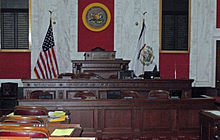West Virginia State Senate
| West Virginia Senate | |
|---|---|
| West Virginia Legislature | |
 |
|
| Type | |
| Type | |
|
Term limits
|
None |
| History | |
|
New session started
|
January 11, 2017 |
| Leadership | |
|
President of the Senate
|
|
|
President pro Tempore
|
|
|
Majority Leader
|
|
|
Minority Leader
|
|
| Structure | |
| Seats | 34 |
 |
|
|
Political groups
|
|
|
Length of term
|
4 years |
| Authority | Article VI, West Virginia Constitution |
| Salary | $20,000/year + per diem |
| Elections | |
|
Last election
|
November 8, 2016 (17 seats) |
|
Next election
|
November 6, 2018 (17 seats) |
| Redistricting | Legislative Control |
| Meeting place | |
 |
|
| Senate Chamber West Virginia State Capitol Charleston, West Virginia |
|
| Website | |
| West Virginia State Legislature | |
The West Virginia Senate is the upper house of the West Virginia Legislature. There are seventeen senatorial districts. Each district has two senators who serve staggered four-year terms.
Senators are elected for terms of four years that are staggered, meaning that only a portion of the 34 state senate seats are up every election.
The state legislature meets on the second Wednesday of January each year and conducts a 60-day regular session.
Unlike most state senates, the West Virginia Senate can introduce revenue bills. Bills must undergo three readings in each house before being sent to the governor. Bills are drafted by the Office of Legislative Services or legislative staff counsel, reviewed by the sponsor of the bill and submitted for introduction. Bills are assigned to committees that make recommendations about a bill in the form of a committee report.
Bills approved in both the West Virginia Senate and West Virginia House of Delegates are then submitted to the governor, who has the power to sign them into law or veto them. The state legislature can override the veto, unless they have already adjourned.
The state's districting system is unique in the United States. Prior to the 2010 Census the state's most populous county, Kanawha County constituted two "superimposed" districts. In practical effect, this meant that Kanawha County was a single district electing two members every two years. The remaining 54 counties of the state were divided into fifteen districts, with county lines not respected in most cases.
Under the unique rule, no multi-county district (and every district except Kanawha's is a multi-county district) may have more than one senator from the same county, no matter the population. This means, for example, that one of the 5th District's two senators must reside in Cabell County and the other must reside in the tiny portion of Wayne County that's inside the 5th District, even though Cabell County has far more people than the portion of Wayne County that is part of the 5th District. However, both senators are elected by everybody within the district, not just by the people of the county in which the senators reside.
...
Wikipedia
